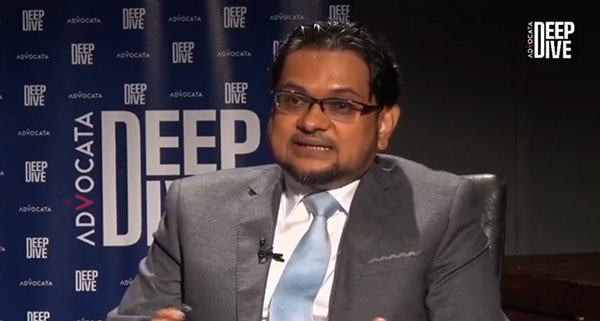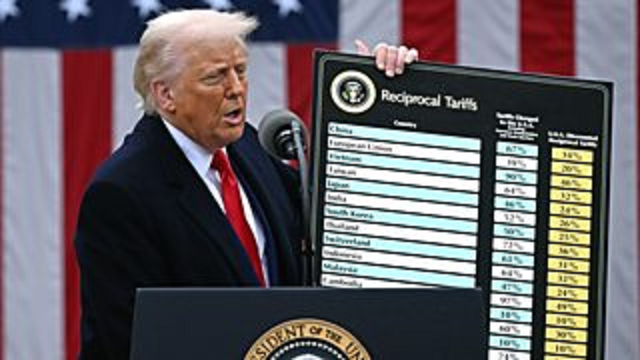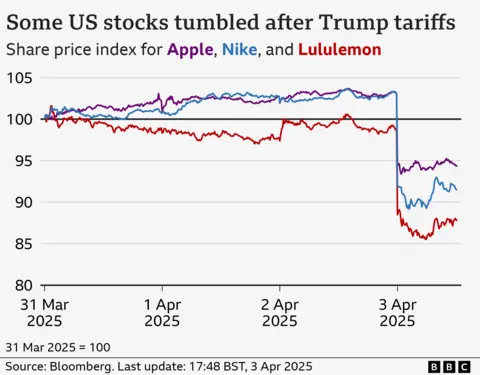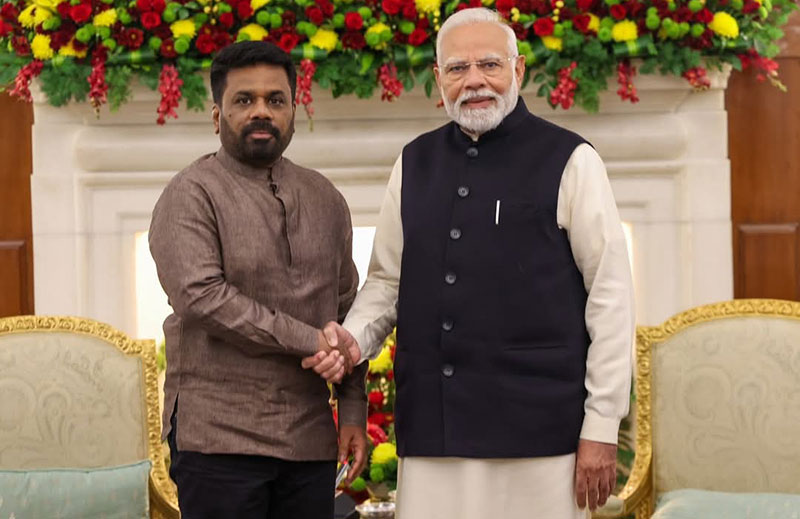Business
IMF or no IMF, Sri Lanka needs Economic Analysis and Plan going forward: Verité Research

BY SANATH NANAYAKKARE
Whatever Sri Lanka decides about dealing with its debt and paying its way through the world, the country needs to formulate a very good economic analysis and a publicly-backed plan that will establishc credibility of the world in its economy going forward, Dr. Nishan De Mel, Executive Director of Verité Research said recently.
He made this remark at a virtual forum conducted by Advocata Institute on ‘How to Resolve Sri Lanka’s Debt Crisis Without Seeking Assistance from the International monetary Fund (IMF)’.
Further speaking he said:
“Such an analysis needs to be thorough and well-structured with the focus on the real economic activity and the financial conditions in the economy. That would be the first step to build credibility of the world about the Sri Lankan economy. It is actually credibility that we lack rather than foreign reserves. If we can build that credibility about us in the countries that we deal with, we may not need assistance from the IMF to resolve our liquidity issue. When such a favourable environment is created and other countries repose their trust in Sri Lanka’s economy, its sovereign credit ratings would see an upgrade and Sri Lanka would be able to raise funds at the international capital market at reasonable interest rates, The skill we need for this is to present an analysis and a plan and then demonstrate our commitment to stick to it. Our concern is whether the government has such a plan and if it does have one, why it is not publicized”.
“I am not recommending that Sri Lanka should or shouldn’t go to IMF. The central question is not that. The central question is whether we can present and adopt an analytical approach to building credibility in the relevant parties about our economy. On the other hand, in the event we decide to go to the IMF at some point, we will still have to have an analysis and a plan.”
Responding to a question on whether Sri Lanka could boost its reserves by building global confidence in that manner, he replied,” When we have a very good policy document, we will need to demonstrate that we are serious about implementing it. Not only IMF, no country would support us without a well-crafted policy document and a frank commitment to actually implement it”
“We started raising funds from the international capital market via international sovereign bonds (ISBs) in 2007-2008. Those loans boosted our reserves. Then we started repayments from 2012. Before that we had not taken that type of loans from the international capital market. As those sovereign bonds increased, our reserves also increased. Before that we had taken concessional loans from foreign countries and lending institutions at low interest rates.”
“Thus we took loans from the international capital market and repaid them maintaining our foreign reserves at stable levels. Such a situation remained in the past 3-5 years. However, that equilibrium unsettled when Sri Lanka substantially reduced its taxes in the fourth quarter of 2019. Due to this substantial change, government taxes fell by about 25%. With Covid the decline was even deeper. Even without Covid, there was the 25% decline in taxes. Our global lenders were stunned by this development as it would further increase the budget deficit making our loan repayments unsustainable. I think that they had some anxiety about it”.
“This tax subsidy was given without an analysis as to whether it would help increase the country’s GDP, government’s income or how it would affect debt dynamics etc. We think that there should have been a rationale for it, but we didn’t see any such thing from the government. At that time, Sri Lanka was on an IMF programme and they probably thought that their facility’s last tranche could not be completed as the economy would not be managed sustainably. Thus the IMF got out of the picture. Then the rating agencies downgraded Sri Lanka according to their analyses. This had an impact on us. In 2019 December, the third downgrade of Sri Lanka took place. Earlier also we had been downgraded in two instances. But the latest rating made it impossible for us to raise funds in the international capital market. This situation complicated the debt- dynamics balance which had been maintained earlier. What has happened now is; we service our loans from the reserves and we can’t refill it like before. This is how this issue actually cropped up in the first place although it is said that it happened due to Covid. Actually Covid exacerbated it as there has been no Tourism receipts. But we have been able to offset that with import restrictions that have been in place. If we didn’t have to service our foreign loans from the reserves, there would not be a crisis at this point. The fact that funds can’t be added to the reserves can be shown as the cause for the current debt crisis.”
“When there is a substantial tax policy change, can we just make an oral statement and justify it? Don’t we need an analysis as to which tax should be reduced and which one shouldn’t, in order to sustainably manage our economy? Here the reality is; when there is no analysis, there is no credibility.”
“The collapse of confidence is the main reason for our economic problem and the decline in reserves. Government says that it won’t borrow from the international capital market and that there is no need to do so. This is heard as a decision made by the government. But it is not a decision. It is a Hobson’s choice. Even if we really want to borrow, we can’t borrow at reasonable interest rates. That’s the issue.”
“Confidence could collapse not only in the absence of an economic analysis. We have gone back on our pledges made to international bodies a number of times. Sad to say that this has become a tradition. So, if we had managed the economy well in the past year, we would have been able to raise loans without help from the IMF. Now we should manage our economy well, before our reserves hit near zero levels or zero.”
“The Central Bank had a medium term debt management strategy for 10 years, and they had published a written document about it three years ago. But now it has been changed and a new strategy is not in place as yet. In the absence of one, you can’t build confidence by making oral statements. People need to have an awareness not only on inflows but also on outflows.”
“Reserves won’t hit zero this year. In 2021, reserves may reach zero sooner or at a later stage. Even if we manage to protract it. it will spill over into the next year and the next year. It will only aggravate. It won’t be resolved. The speed of going towards zero reserves could be faster or slower, but it won’t deviate from where it’s heading. International parties analyse Sri Lanka and they have not changed their analyses. But the government has often changed its policy. For example, the foreign exchange policy was changed many times. This shows that the economy is not moving as the government expects it to. Verité Research has done an economic analysis on Sri Lanka considering its economic activities, GDP, inflows, debt obligations etc. Our predictions have remained valid but the government is not taking them into account. That’s the problem.”
“The government has presented its expectations, not a plan. The difference between a gamble and a plan is analysis. Expectations are not considered as an analysis”.
“If reserves come to zero at one point, we will have to tell our creditors that we will pay only the interest and pay the principal later. We need to sort things out before we face a disorderly default. Such a situation will affect the economy even more. Our banks, our private sector won’t be able to deal with their parties in the international arena. So we need to negotiate well before such an eventuality happens and resolve the crisis in an orderly manner.”
When asked, in such a scenario could Sri Lanka negotiate with the creditors on its own, he said,” We may need help from the IMF to talk to the creditors being these are bond sales involving hundreds of people. The IMF has a service for this sort of structural help – not reserves help – in order to negotiate with creditors and arrive at an agreement. In the event of making an orderly default, help of the IMF would be needed,” Dr. Nishan De Mel said.
Business
Trump tariffs trigger steepest US stocks drop since 2020 as China, EU vow to hit back

Global stocks have sunk, a day after President Donald Trump announced sweeping new tariffs that are forecast to raise prices and weigh on growth in the US and abroad.
Stock markets in the Asia-Pacific region fell for a second day, hot on the heels of the US S&P 500, which had its worst day since Covid crashed the economy in 2020.
Nike, Apple and Target were among big consumer names worst hit, all of them sinking by more than 9%.
At the White House, Trump told reporters the US economy would “boom” thanks to the minimum 10% tariff he plans to slap on imports in the hope of boosting federal revenues and bringing American manufacturing home.
The Republican president plans to hit products from dozens of other countries with far higher levies, including trade partners such as China and the European Union. China, which is facing an aggregate 54% tariff, and the EU, which faces duties of 20%, both vowed retaliation on Thursday.
Tariffs are taxes on goods imported from other countries, and Trump’s plan that he announced on Wednesday would hike such duties to some of the highest levels in more than 100 years.
The World Trade Organization said it was “deeply concerned”, estimating trade volumes could shrink as a result by 1% this year.
Traders expressed concern that the tariffs could stoke inflation and stall growth.
In early trading on Friday, Japan’s benchmark Nikkei 225 index fell by 1.8%, the Kospi in South Korea was around 1% lower and Australia’s ASX 200 dipped by 1.4%.
On Thursday, the S&P 500 – which tracks 500 of the biggest American firms – plunged 4.8%, shedding roughly $2tn in value.
The Dow Jones closed about 4% lower, while the Nasdaq tumbled roughly 6%. The US shares sell-off has been going on since mid-February amid trade war fears.
Earlier, the UK’s FTSE 100 share index dropped 1.5% and other European markets also fell, echoing declines from Japan to Hong Kong.
On Thursday at the White House, Trump doubled down on a high-stakes gambit aimed at reversing decades of US-led liberalisation that shaped the global trade order.
“I think it’s going very well,” he said. “It was an operation like when a patient gets operated on, and it’s a big thing. I said this would exactly be the way it is.”
He added: “The markets are going to boom. The stock is going to boom. The country is going to boom.”
Trump also said he was open to negotiating with trade partners on the tariffs “if somebody said we’re going to give you something that’s so phenomenal”.
On Thursday, Canada’s Prime Minister Mark Carney said that country would retaliate with a 25% levy on vehicles imported from the US.
Trump last month imposed tariffs of 25% on Canada and Mexico, though he did not announce any new duties on Wednesday against the North American trade partners.

Firms now face a choice of swallowing the tariff cost, working with partners to share that burden, or passing it on to consumers – and risking a drop in sales.
That could have a major impact as US consumer spending amounts to about 10% – 15% of the world economy, according to some estimates.
While stocks fell on Thursday, the price of gold, which is seen as a safer asset in times of turbulence, touched a record high of $3,167.57 an ounce at one point on Thursday, before falling back.
The dollar also weakened against many other currencies.
In Europe, the tariffs could drag down growth by nearly a percentage point, with a further hit if the bloc retaliates, according to analysts at Principal Asset Management.
In the US, a recession is likely to materialise without other changes, such as big tax cuts, which Trump has also promised, warned Seema Shah, chief global strategist at the firm.
She said Trump’s goals of boosting manufacturing would be a years-long process “if it happens at all”.
“In the meantime, the steep tariffs on imports are likely to be an immediate drag on the economy, with limited short-term benefit,” she said.
On Thursday, Stellantis, which makes Jeep, Fiat and other brands, said it was temporarily halting production at a factory in Toluca, Mexico and Windsor, Canada.
It said the move, a response to Trump’s 25% tax on car imports, would also lead to temporary layoffs of 900 people at five plants in the US that supply those factories.
On the stock market, Nike, which makes much of its sportswear in Asia, was among the hardest hit on the S&P, with shares down 14%.
Shares in Apple, which relies heavily on China and Taiwan, tumbled 9%.
Other retailers also fell, with Target down roughly 10%.
Motorbike maker Harley-Davidson – which was subject of retaliatory tariffs by the EU during Trump’s first term as president – fell 10%.
In Europe, shares in sportswear firm Adidas fell more than 10%, while stocks in rival Puma tumbled more than 9%.
Among luxury goods firms, jewellery maker Pandora fell more than 10%, and LVMH (Louis Vuitton Moet Hennessy) dropped more than 3% after tariffs were imposed on the European Union and Switzerland.
“You’re seeing retailers get destroyed right now because tariffs extended to countries we did not expect,” said Jay Woods, chief global strategy at Freedom Capital Markets, adding that he expected more turbulence ahead.
[BBC]
Business
Overcoming initial delays, Sampur solar energy project becomes a reality

The long-anticipated Sampur solar energy project is finally set to break ground, marking a significant leap in Sri Lanka’s renewable energy ambitions. After years of delays and negotiations, the Power Purchase Agreement (PPA) for the Surya Danavi 120 MW Solar Farm in Santhosapuram, Trincomalee District, was officially signed on April 1st between the National Thermal Power Corporation of India (NTPC) and the Ceylon Electricity Board (CEB).
This initiative, spearheaded by Trincomalee Power Company Limited (TPCL), a 50:50 joint venture between NTPC and CEB, is expected to be a game-changer in the country’s energy landscape.
The project will be implemented in two phases. Phase 1 involves the installation of a 50 MW solar plant along with the construction of 37 km of 220 kV transmission lines connecting Sampur to Kappalthurai. In Phase 2, an additional 70 MW capacity will be added, complemented by 77 km of transmission lines extending from Kappalthurai to New Habarana.
President Anura Kumara Dissanayake played a crucial role in renegotiating the unit tariff to 5.97 US Cents, which includes a battery storage system to mitigate fluctuations in solar power generation.
According to Ministry of Energy Director General Eng. Pubudu Niroshan Hedigallage, this project is a testament to Sri Lanka’s commitment to renewable energy and energy security.
“For years, Sampur has been at the center of numerous energy debates. This project not only signifies the shift from fossil fuels to cleaner alternatives but also strengthens our grid resilience. The inclusion of battery storage makes this project particularly promising, said Hedigallage.
He further emphasized the importance of strategic partnerships in achieving energy sustainability. “Collaborations like the one between NTPC and CEB show the potential of cross-border energy projects. With India’s vast experience in solar energy, Sri Lanka can benefit immensely in terms of both technology transfer and cost efficiency.”
The Sampur region has long been embroiled in energy-related controversies. Previously earmarked for a coal power plant, the area saw fierce opposition from environmental activists and policy shifts that led to its cancellation. The transition from coal to solar in Sampur is seen as a redemption of sorts, aligning with global climate goals and Sri Lanka’s own commitment to increasing renewable energy in its power mix.
by Ifham Nizam
Business
SriLankan Airlines positioning Sri Lanka as a hub for culturally discerning travellers

SriLankan Airlines is amplifying its commitment to nurturing Sri Lanka’s performing arts scene, leveraging classical Western music and homegrown talent to position the island as a hub for culturally discerning travelers.
The national carrier partnered with the Gustav Mahler Society of Colombo (GMSC) to support the 2025 Spring Concert at Colombo’s Lionel Wendt Theatre on March 29.
The event showcased Sri Lankan classical guitarist Jude Peiris alongside Japanese artists Hiroshi Kogure (violin) and Miyuki Funatsu (soprano), blending local and global artistry. This marks the airline’s sixth collaboration with GMSC, reinforcing its three-year role as the society’s Official Airline Partner.
Dimuthu Tennakoon, Head of Commercial at SriLankan Airlines, emphasised the strategic value of performing arts saying: “World-class cultural productions can transform Sri Lanka into a magnet for travelers seeking immersive experiences. By honing local talent, we unlock immense potential in the growing cultural tourism sector.”
Deepal Perera, Manager of Corporate Communications, highlighted the airline’s dual role: “We’re not just bridging geographies—we’re fostering global exchanges of music and tradition. Sri Lankan artists deserve platforms to shine internationally, and partnerships like this propel them forward.”
GMSC’s Music Director, Srimal Weerasinghe, praised the airline’s impact: “SriLankan Airlines has been instrumental in developing Western classical music here, sponsoring visiting professionals and helping build Sri Lanka’s first professional orchestra. Their support has elevated our global reputation.”
Beyond GMSC, SriLankan Airlines continues to partner with local arts groups and diplomatic missions, cementing its role as a cultural ambassador.
By Sanath Nanayakkare
-

 News5 days ago
News5 days agoBid to include genocide allegation against Sri Lanka in Canada’s school curriculum thwarted
-

 Sports6 days ago
Sports6 days agoSri Lanka’s eternal search for the elusive all-rounder
-

 News7 days ago
News7 days agoGnanasara Thera urged to reveal masterminds behind Easter Sunday terror attacks
-

 Sports2 days ago
Sports2 days agoTo play or not to play is Richmond’s decision
-

 News6 days ago
News6 days agoComBank crowned Global Finance Best SME Bank in Sri Lanka for 3rd successive year
-

 Features6 days ago
Features6 days agoSanctions by The Unpunished
-

 Features6 days ago
Features6 days agoMore parliamentary giants I was privileged to know
-

 Latest News4 days ago
Latest News4 days agoIPL 2025: Rookies Ashwani and Rickelton lead Mumbai Indians to first win











